HI5003 Economics for Business: Coles Supermarket Industry Report
VerifiedAdded on 2023/03/17
|16
|4022
|44
Report
AI Summary
This economics report provides a comprehensive analysis of Coles Supermarket within the Australian grocery industry. It begins with background information on Coles, its market share, and an overview of the grocery sector's significance to the Australian economy. The report then delves into the market structure, classifying it as an oligopoly and detailing its characteristics such as limited sellers, interdependence, advertising, competition, and barriers to entry. Competitor performance, particularly Woolworths, is also assessed. Furthermore, the report explores the factors influencing demand and supply, including consumer preferences, income levels, input costs, and government policies. It also examines elasticity and its determining factors, such as total spending and time duration, providing insights into price sensitivity. The report concludes with a market analysis and appendices with key economic indicators such as GDP, inflation, and unemployment rates and exchange rates to provide context.
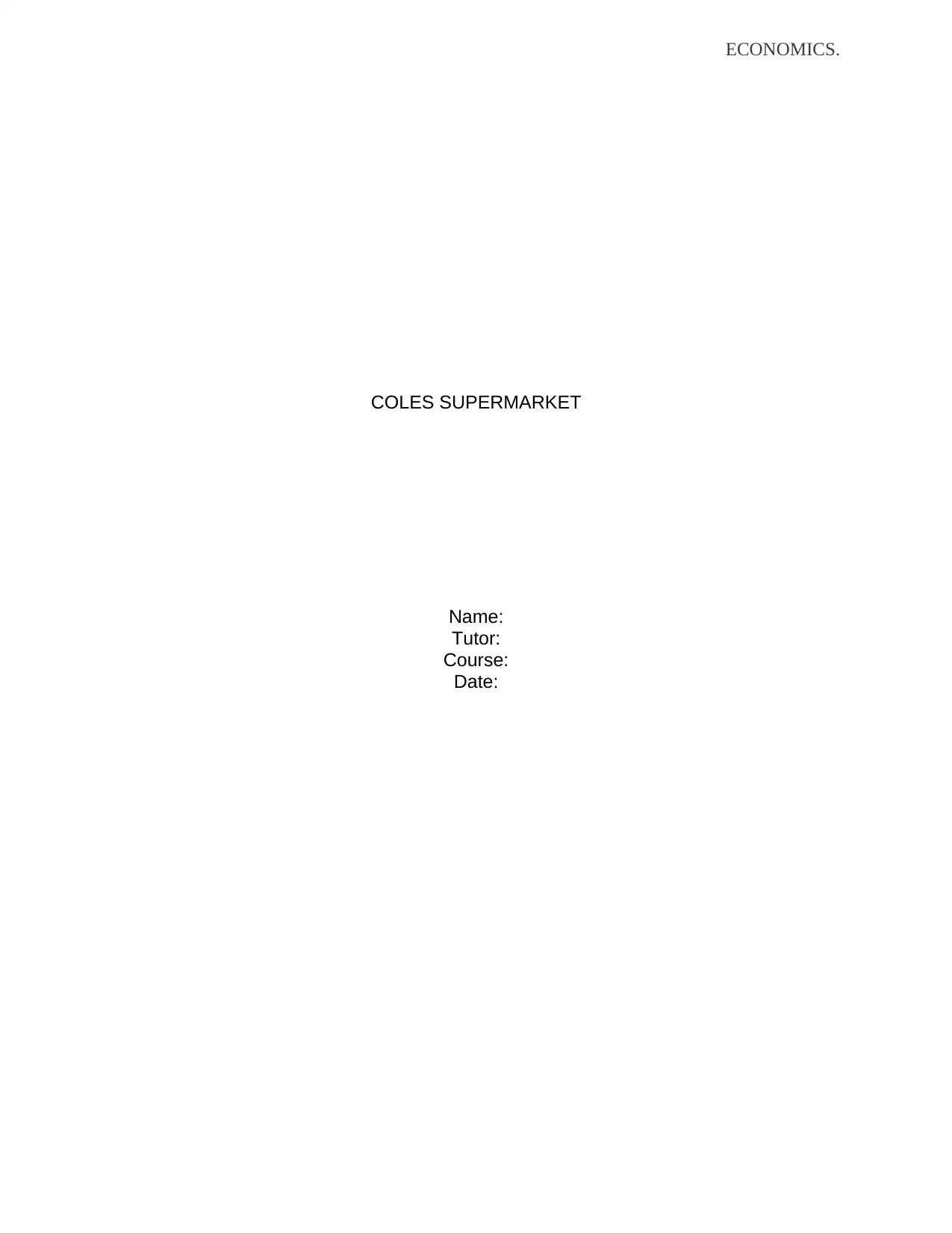
ECONOMICS.
COLES SUPERMARKET
Name:
Tutor:
Course:
Date:
COLES SUPERMARKET
Name:
Tutor:
Course:
Date:
Paraphrase This Document
Need a fresh take? Get an instant paraphrase of this document with our AI Paraphraser
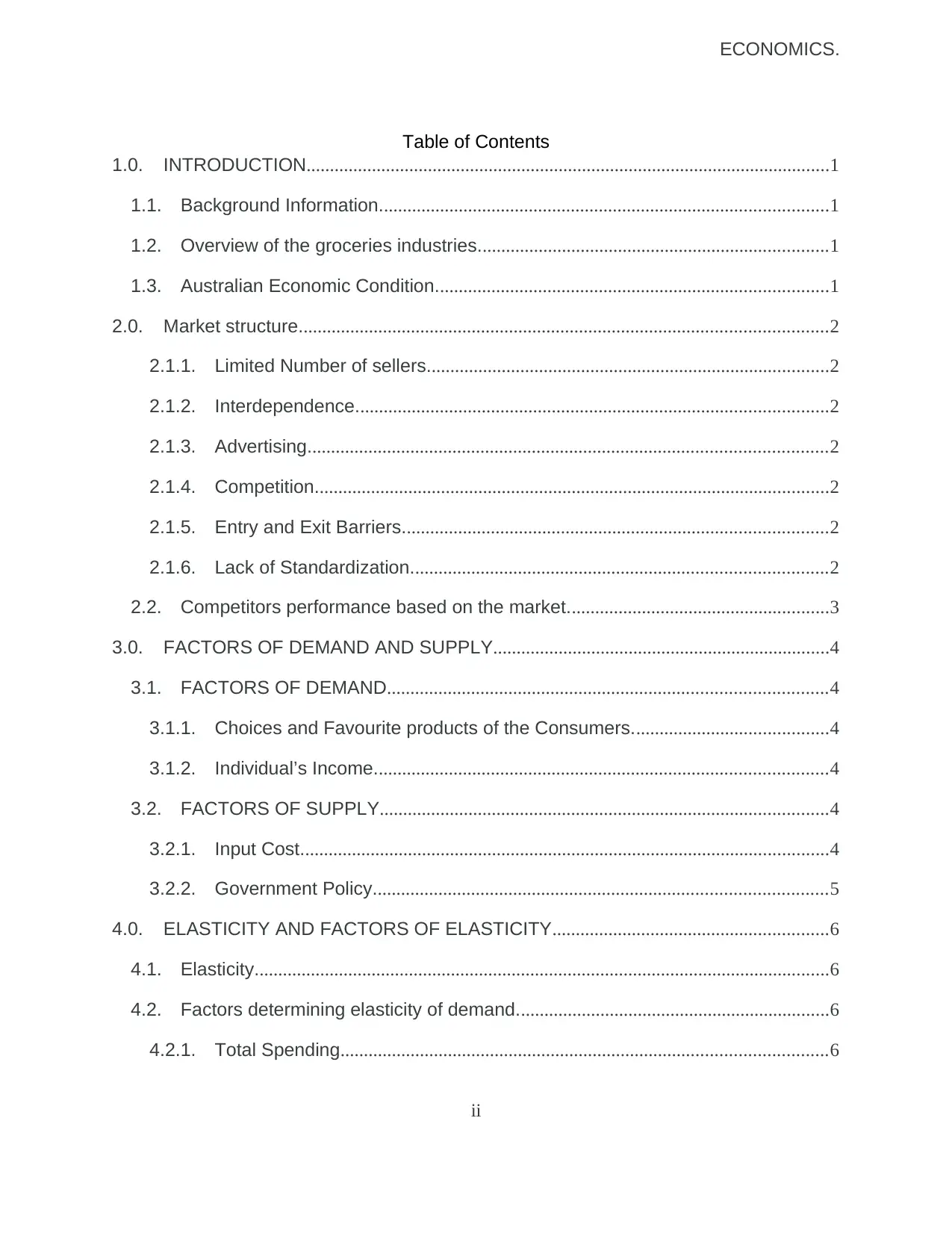
ECONOMICS.
Table of Contents
1.0. INTRODUCTION................................................................................................................1
1.1. Background Information................................................................................................1
1.2. Overview of the groceries industries...........................................................................1
1.3. Australian Economic Condition....................................................................................1
2.0. Market structure.................................................................................................................2
2.1.1. Limited Number of sellers......................................................................................2
2.1.2. Interdependence.....................................................................................................2
2.1.3. Advertising...............................................................................................................2
2.1.4. Competition..............................................................................................................2
2.1.5. Entry and Exit Barriers...........................................................................................2
2.1.6. Lack of Standardization.........................................................................................2
2.2. Competitors performance based on the market........................................................3
3.0. FACTORS OF DEMAND AND SUPPLY........................................................................4
3.1. FACTORS OF DEMAND..............................................................................................4
3.1.1. Choices and Favourite products of the Consumers..........................................4
3.1.2. Individual’s Income.................................................................................................4
3.2. FACTORS OF SUPPLY................................................................................................4
3.2.1. Input Cost.................................................................................................................4
3.2.2. Government Policy.................................................................................................5
4.0. ELASTICITY AND FACTORS OF ELASTICITY...........................................................6
4.1. Elasticity...........................................................................................................................6
4.2. Factors determining elasticity of demand...................................................................6
4.2.1. Total Spending........................................................................................................6
ii
Table of Contents
1.0. INTRODUCTION................................................................................................................1
1.1. Background Information................................................................................................1
1.2. Overview of the groceries industries...........................................................................1
1.3. Australian Economic Condition....................................................................................1
2.0. Market structure.................................................................................................................2
2.1.1. Limited Number of sellers......................................................................................2
2.1.2. Interdependence.....................................................................................................2
2.1.3. Advertising...............................................................................................................2
2.1.4. Competition..............................................................................................................2
2.1.5. Entry and Exit Barriers...........................................................................................2
2.1.6. Lack of Standardization.........................................................................................2
2.2. Competitors performance based on the market........................................................3
3.0. FACTORS OF DEMAND AND SUPPLY........................................................................4
3.1. FACTORS OF DEMAND..............................................................................................4
3.1.1. Choices and Favourite products of the Consumers..........................................4
3.1.2. Individual’s Income.................................................................................................4
3.2. FACTORS OF SUPPLY................................................................................................4
3.2.1. Input Cost.................................................................................................................4
3.2.2. Government Policy.................................................................................................5
4.0. ELASTICITY AND FACTORS OF ELASTICITY...........................................................6
4.1. Elasticity...........................................................................................................................6
4.2. Factors determining elasticity of demand...................................................................6
4.2.1. Total Spending........................................................................................................6
ii
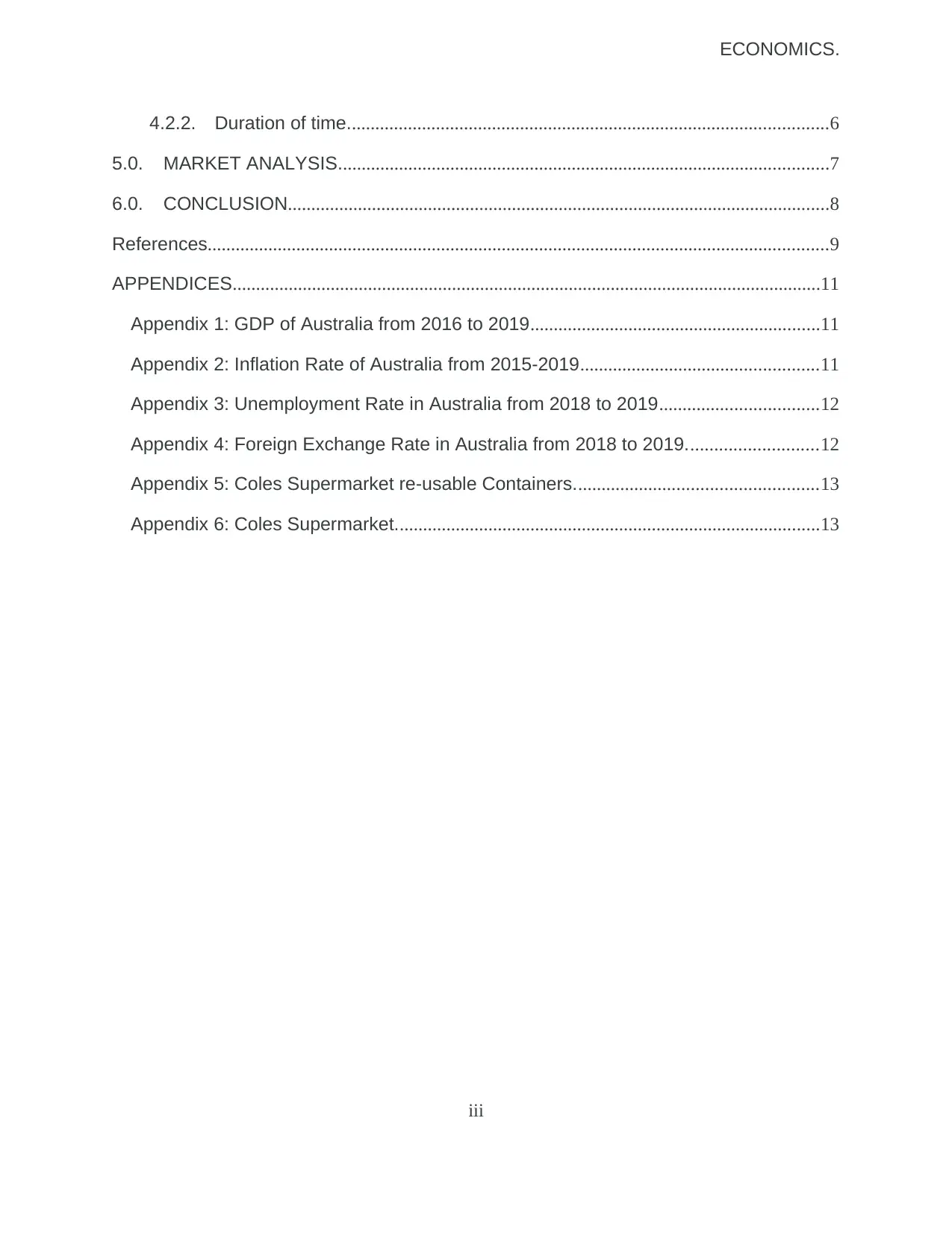
ECONOMICS.
4.2.2. Duration of time.......................................................................................................6
5.0. MARKET ANALYSIS.........................................................................................................7
6.0. CONCLUSION....................................................................................................................8
References.....................................................................................................................................9
APPENDICES..............................................................................................................................11
Appendix 1: GDP of Australia from 2016 to 2019..............................................................11
Appendix 2: Inflation Rate of Australia from 2015-2019...................................................11
Appendix 3: Unemployment Rate in Australia from 2018 to 2019..................................12
Appendix 4: Foreign Exchange Rate in Australia from 2018 to 2019............................12
Appendix 5: Coles Supermarket re-usable Containers....................................................13
Appendix 6: Coles Supermarket...........................................................................................13
iii
4.2.2. Duration of time.......................................................................................................6
5.0. MARKET ANALYSIS.........................................................................................................7
6.0. CONCLUSION....................................................................................................................8
References.....................................................................................................................................9
APPENDICES..............................................................................................................................11
Appendix 1: GDP of Australia from 2016 to 2019..............................................................11
Appendix 2: Inflation Rate of Australia from 2015-2019...................................................11
Appendix 3: Unemployment Rate in Australia from 2018 to 2019..................................12
Appendix 4: Foreign Exchange Rate in Australia from 2018 to 2019............................12
Appendix 5: Coles Supermarket re-usable Containers....................................................13
Appendix 6: Coles Supermarket...........................................................................................13
iii
⊘ This is a preview!⊘
Do you want full access?
Subscribe today to unlock all pages.

Trusted by 1+ million students worldwide
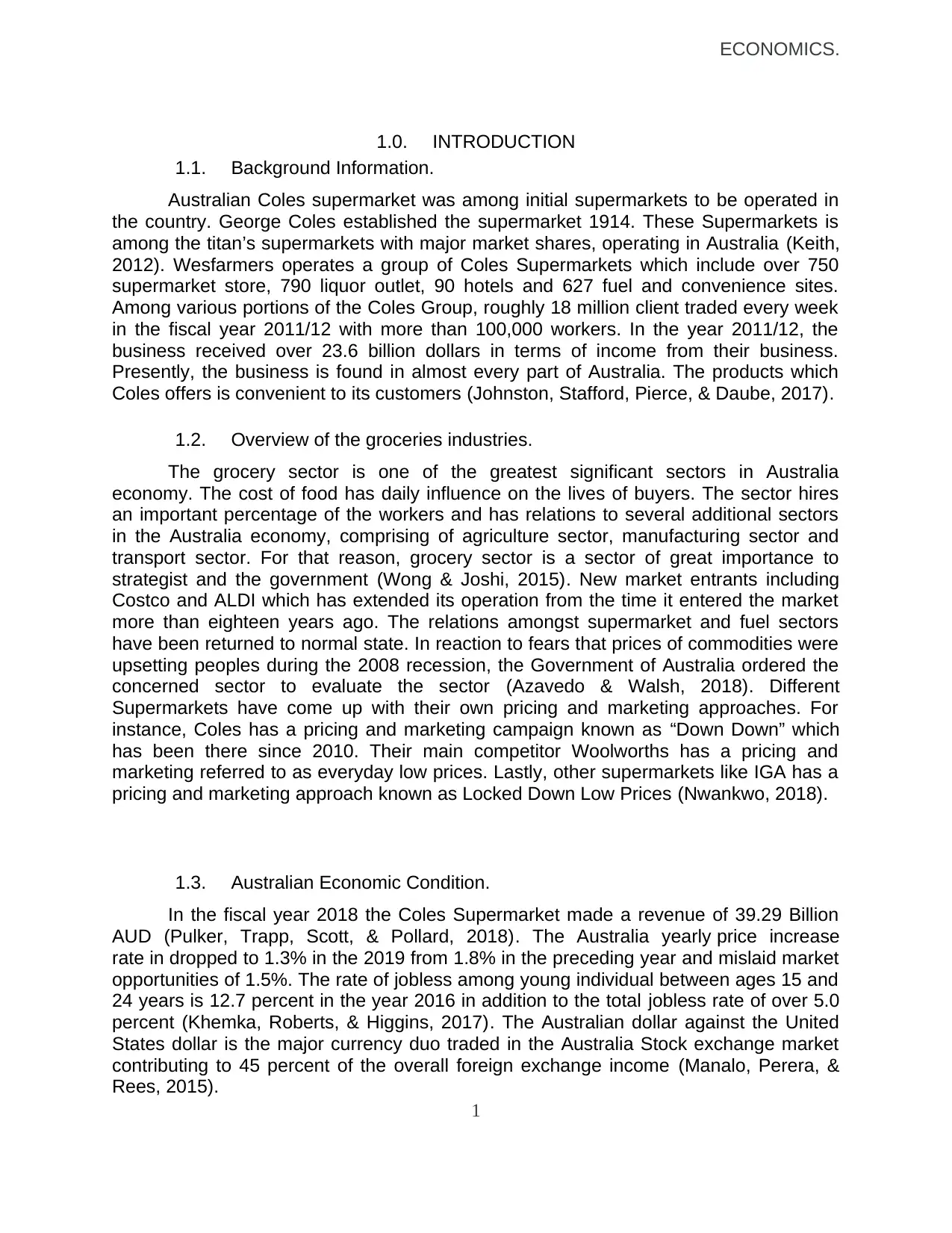
ECONOMICS.
1.0. INTRODUCTION
1.1. Background Information.
Australian Coles supermarket was among initial supermarkets to be operated in
the country. George Coles established the supermarket 1914. These Supermarkets is
among the titan’s supermarkets with major market shares, operating in Australia (Keith,
2012). Wesfarmers operates a group of Coles Supermarkets which include over 750
supermarket store, 790 liquor outlet, 90 hotels and 627 fuel and convenience sites.
Among various portions of the Coles Group, roughly 18 million client traded every week
in the fiscal year 2011/12 with more than 100,000 workers. In the year 2011/12, the
business received over 23.6 billion dollars in terms of income from their business.
Presently, the business is found in almost every part of Australia. The products which
Coles offers is convenient to its customers (Johnston, Stafford, Pierce, & Daube, 2017).
1.2. Overview of the groceries industries.
The grocery sector is one of the greatest significant sectors in Australia
economy. The cost of food has daily influence on the lives of buyers. The sector hires
an important percentage of the workers and has relations to several additional sectors
in the Australia economy, comprising of agriculture sector, manufacturing sector and
transport sector. For that reason, grocery sector is a sector of great importance to
strategist and the government (Wong & Joshi, 2015). New market entrants including
Costco and ALDI which has extended its operation from the time it entered the market
more than eighteen years ago. The relations amongst supermarket and fuel sectors
have been returned to normal state. In reaction to fears that prices of commodities were
upsetting peoples during the 2008 recession, the Government of Australia ordered the
concerned sector to evaluate the sector (Azavedo & Walsh, 2018). Different
Supermarkets have come up with their own pricing and marketing approaches. For
instance, Coles has a pricing and marketing campaign known as “Down Down” which
has been there since 2010. Their main competitor Woolworths has a pricing and
marketing referred to as everyday low prices. Lastly, other supermarkets like IGA has a
pricing and marketing approach known as Locked Down Low Prices (Nwankwo, 2018).
1.3. Australian Economic Condition.
In the fiscal year 2018 the Coles Supermarket made a revenue of 39.29 Billion
AUD (Pulker, Trapp, Scott, & Pollard, 2018). The Australia yearly price increase
rate in dropped to 1.3% in the 2019 from 1.8% in the preceding year and mislaid market
opportunities of 1.5%. The rate of jobless among young individual between ages 15 and
24 years is 12.7 percent in the year 2016 in addition to the total jobless rate of over 5.0
percent (Khemka, Roberts, & Higgins, 2017). The Australian dollar against the United
States dollar is the major currency duo traded in the Australia Stock exchange market
contributing to 45 percent of the overall foreign exchange income (Manalo, Perera, &
Rees, 2015).
1
1.0. INTRODUCTION
1.1. Background Information.
Australian Coles supermarket was among initial supermarkets to be operated in
the country. George Coles established the supermarket 1914. These Supermarkets is
among the titan’s supermarkets with major market shares, operating in Australia (Keith,
2012). Wesfarmers operates a group of Coles Supermarkets which include over 750
supermarket store, 790 liquor outlet, 90 hotels and 627 fuel and convenience sites.
Among various portions of the Coles Group, roughly 18 million client traded every week
in the fiscal year 2011/12 with more than 100,000 workers. In the year 2011/12, the
business received over 23.6 billion dollars in terms of income from their business.
Presently, the business is found in almost every part of Australia. The products which
Coles offers is convenient to its customers (Johnston, Stafford, Pierce, & Daube, 2017).
1.2. Overview of the groceries industries.
The grocery sector is one of the greatest significant sectors in Australia
economy. The cost of food has daily influence on the lives of buyers. The sector hires
an important percentage of the workers and has relations to several additional sectors
in the Australia economy, comprising of agriculture sector, manufacturing sector and
transport sector. For that reason, grocery sector is a sector of great importance to
strategist and the government (Wong & Joshi, 2015). New market entrants including
Costco and ALDI which has extended its operation from the time it entered the market
more than eighteen years ago. The relations amongst supermarket and fuel sectors
have been returned to normal state. In reaction to fears that prices of commodities were
upsetting peoples during the 2008 recession, the Government of Australia ordered the
concerned sector to evaluate the sector (Azavedo & Walsh, 2018). Different
Supermarkets have come up with their own pricing and marketing approaches. For
instance, Coles has a pricing and marketing campaign known as “Down Down” which
has been there since 2010. Their main competitor Woolworths has a pricing and
marketing referred to as everyday low prices. Lastly, other supermarkets like IGA has a
pricing and marketing approach known as Locked Down Low Prices (Nwankwo, 2018).
1.3. Australian Economic Condition.
In the fiscal year 2018 the Coles Supermarket made a revenue of 39.29 Billion
AUD (Pulker, Trapp, Scott, & Pollard, 2018). The Australia yearly price increase
rate in dropped to 1.3% in the 2019 from 1.8% in the preceding year and mislaid market
opportunities of 1.5%. The rate of jobless among young individual between ages 15 and
24 years is 12.7 percent in the year 2016 in addition to the total jobless rate of over 5.0
percent (Khemka, Roberts, & Higgins, 2017). The Australian dollar against the United
States dollar is the major currency duo traded in the Australia Stock exchange market
contributing to 45 percent of the overall foreign exchange income (Manalo, Perera, &
Rees, 2015).
1
Paraphrase This Document
Need a fresh take? Get an instant paraphrase of this document with our AI Paraphraser
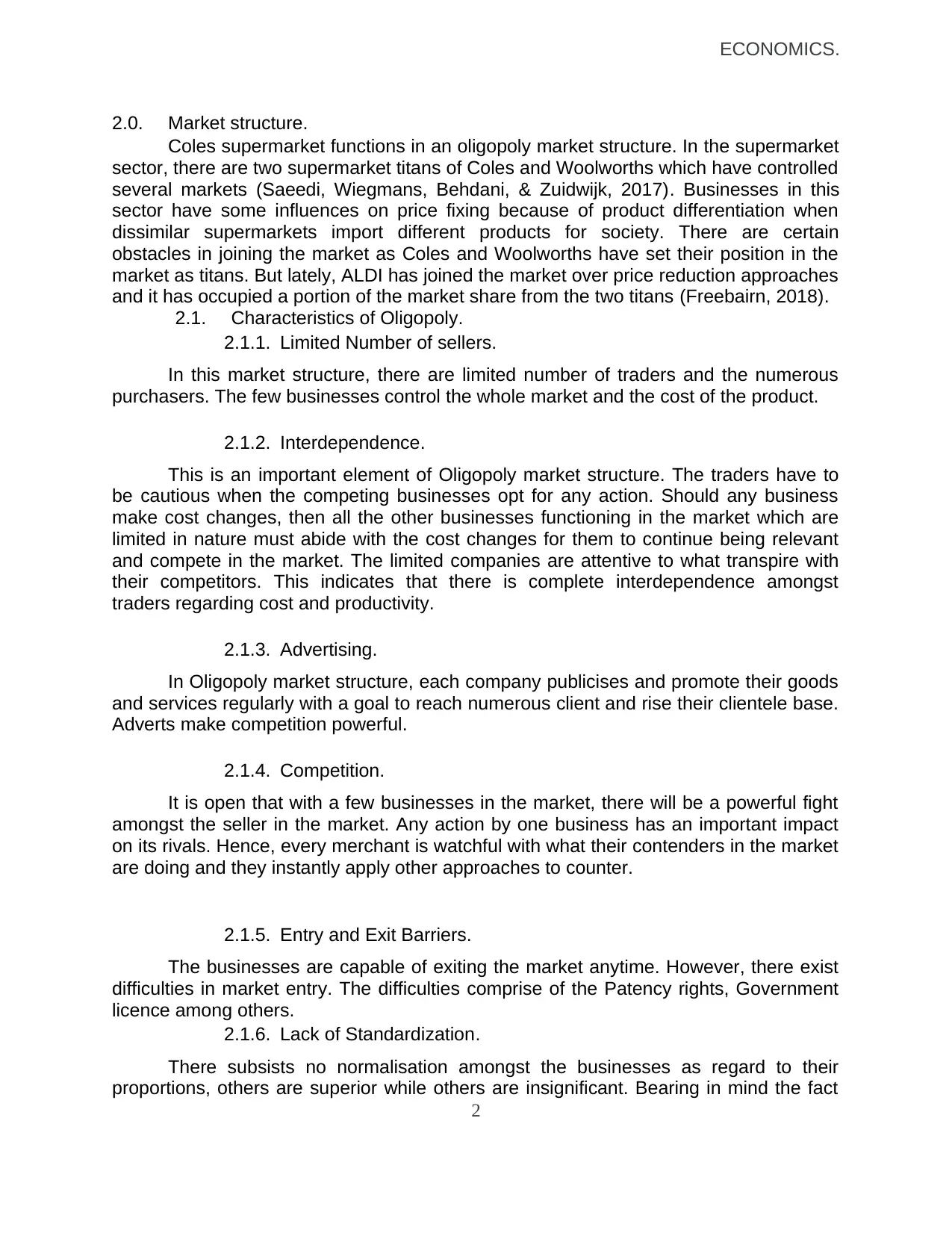
ECONOMICS.
2.0. Market structure.
Coles supermarket functions in an oligopoly market structure. In the supermarket
sector, there are two supermarket titans of Coles and Woolworths which have controlled
several markets (Saeedi, Wiegmans, Behdani, & Zuidwijk, 2017). Businesses in this
sector have some influences on price fixing because of product differentiation when
dissimilar supermarkets import different products for society. There are certain
obstacles in joining the market as Coles and Woolworths have set their position in the
market as titans. But lately, ALDI has joined the market over price reduction approaches
and it has occupied a portion of the market share from the two titans (Freebairn, 2018).
2.1. Characteristics of Oligopoly.
2.1.1. Limited Number of sellers.
In this market structure, there are limited number of traders and the numerous
purchasers. The few businesses control the whole market and the cost of the product.
2.1.2. Interdependence.
This is an important element of Oligopoly market structure. The traders have to
be cautious when the competing businesses opt for any action. Should any business
make cost changes, then all the other businesses functioning in the market which are
limited in nature must abide with the cost changes for them to continue being relevant
and compete in the market. The limited companies are attentive to what transpire with
their competitors. This indicates that there is complete interdependence amongst
traders regarding cost and productivity.
2.1.3. Advertising.
In Oligopoly market structure, each company publicises and promote their goods
and services regularly with a goal to reach numerous client and rise their clientele base.
Adverts make competition powerful.
2.1.4. Competition.
It is open that with a few businesses in the market, there will be a powerful fight
amongst the seller in the market. Any action by one business has an important impact
on its rivals. Hence, every merchant is watchful with what their contenders in the market
are doing and they instantly apply other approaches to counter.
2.1.5. Entry and Exit Barriers.
The businesses are capable of exiting the market anytime. However, there exist
difficulties in market entry. The difficulties comprise of the Patency rights, Government
licence among others.
2.1.6. Lack of Standardization.
There subsists no normalisation amongst the businesses as regard to their
proportions, others are superior while others are insignificant. Bearing in mind the fact
2
2.0. Market structure.
Coles supermarket functions in an oligopoly market structure. In the supermarket
sector, there are two supermarket titans of Coles and Woolworths which have controlled
several markets (Saeedi, Wiegmans, Behdani, & Zuidwijk, 2017). Businesses in this
sector have some influences on price fixing because of product differentiation when
dissimilar supermarkets import different products for society. There are certain
obstacles in joining the market as Coles and Woolworths have set their position in the
market as titans. But lately, ALDI has joined the market over price reduction approaches
and it has occupied a portion of the market share from the two titans (Freebairn, 2018).
2.1. Characteristics of Oligopoly.
2.1.1. Limited Number of sellers.
In this market structure, there are limited number of traders and the numerous
purchasers. The few businesses control the whole market and the cost of the product.
2.1.2. Interdependence.
This is an important element of Oligopoly market structure. The traders have to
be cautious when the competing businesses opt for any action. Should any business
make cost changes, then all the other businesses functioning in the market which are
limited in nature must abide with the cost changes for them to continue being relevant
and compete in the market. The limited companies are attentive to what transpire with
their competitors. This indicates that there is complete interdependence amongst
traders regarding cost and productivity.
2.1.3. Advertising.
In Oligopoly market structure, each company publicises and promote their goods
and services regularly with a goal to reach numerous client and rise their clientele base.
Adverts make competition powerful.
2.1.4. Competition.
It is open that with a few businesses in the market, there will be a powerful fight
amongst the seller in the market. Any action by one business has an important impact
on its rivals. Hence, every merchant is watchful with what their contenders in the market
are doing and they instantly apply other approaches to counter.
2.1.5. Entry and Exit Barriers.
The businesses are capable of exiting the market anytime. However, there exist
difficulties in market entry. The difficulties comprise of the Patency rights, Government
licence among others.
2.1.6. Lack of Standardization.
There subsists no normalisation amongst the businesses as regard to their
proportions, others are superior while others are insignificant. Bearing in mind the fact
2
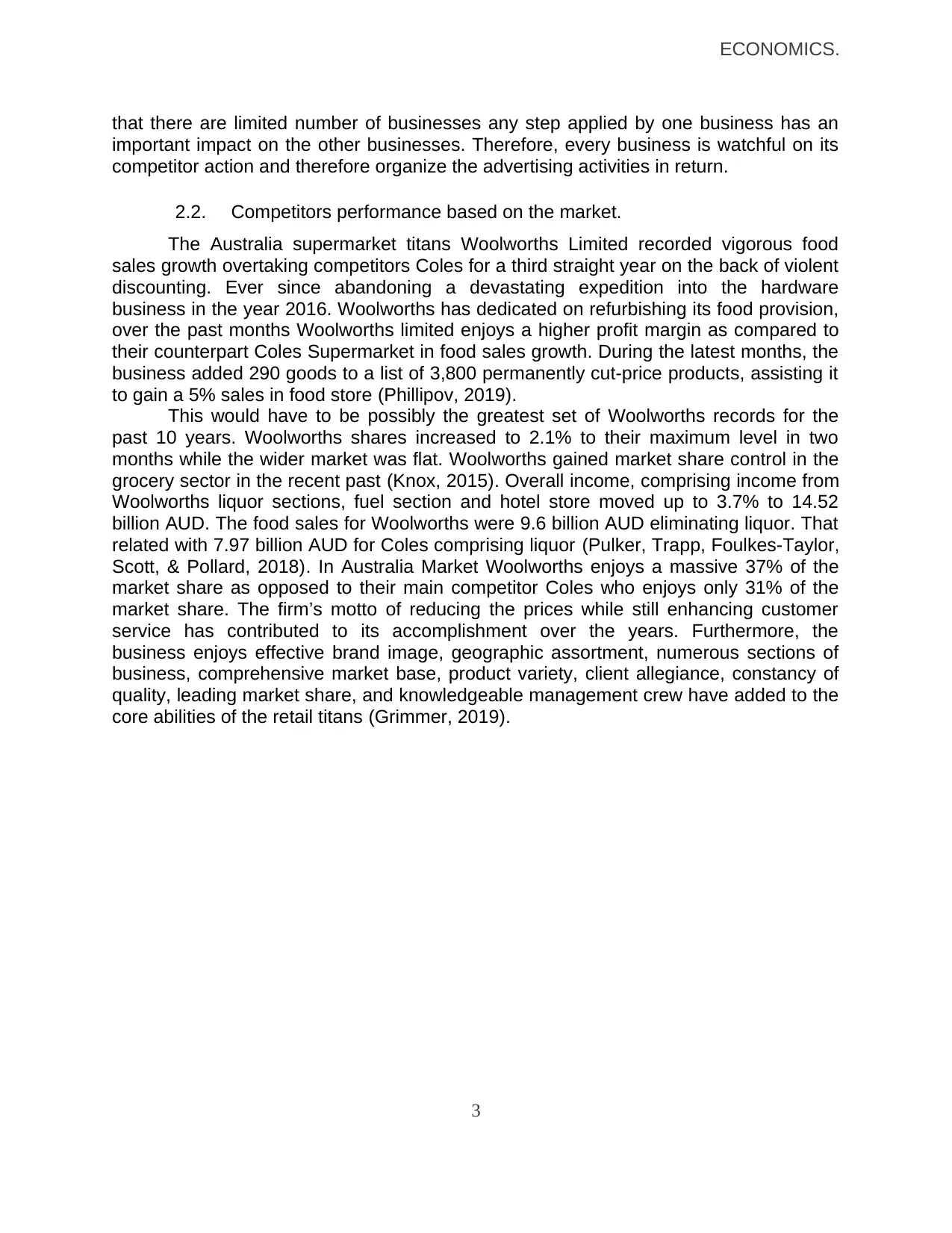
ECONOMICS.
that there are limited number of businesses any step applied by one business has an
important impact on the other businesses. Therefore, every business is watchful on its
competitor action and therefore organize the advertising activities in return.
2.2. Competitors performance based on the market.
The Australia supermarket titans Woolworths Limited recorded vigorous food
sales growth overtaking competitors Coles for a third straight year on the back of violent
discounting. Ever since abandoning a devastating expedition into the hardware
business in the year 2016. Woolworths has dedicated on refurbishing its food provision,
over the past months Woolworths limited enjoys a higher profit margin as compared to
their counterpart Coles Supermarket in food sales growth. During the latest months, the
business added 290 goods to a list of 3,800 permanently cut-price products, assisting it
to gain a 5% sales in food store (Phillipov, 2019).
This would have to be possibly the greatest set of Woolworths records for the
past 10 years. Woolworths shares increased to 2.1% to their maximum level in two
months while the wider market was flat. Woolworths gained market share control in the
grocery sector in the recent past (Knox, 2015). Overall income, comprising income from
Woolworths liquor sections, fuel section and hotel store moved up to 3.7% to 14.52
billion AUD. The food sales for Woolworths were 9.6 billion AUD eliminating liquor. That
related with 7.97 billion AUD for Coles comprising liquor (Pulker, Trapp, Foulkes-Taylor,
Scott, & Pollard, 2018). In Australia Market Woolworths enjoys a massive 37% of the
market share as opposed to their main competitor Coles who enjoys only 31% of the
market share. The firm’s motto of reducing the prices while still enhancing customer
service has contributed to its accomplishment over the years. Furthermore, the
business enjoys effective brand image, geographic assortment, numerous sections of
business, comprehensive market base, product variety, client allegiance, constancy of
quality, leading market share, and knowledgeable management crew have added to the
core abilities of the retail titans (Grimmer, 2019).
3
that there are limited number of businesses any step applied by one business has an
important impact on the other businesses. Therefore, every business is watchful on its
competitor action and therefore organize the advertising activities in return.
2.2. Competitors performance based on the market.
The Australia supermarket titans Woolworths Limited recorded vigorous food
sales growth overtaking competitors Coles for a third straight year on the back of violent
discounting. Ever since abandoning a devastating expedition into the hardware
business in the year 2016. Woolworths has dedicated on refurbishing its food provision,
over the past months Woolworths limited enjoys a higher profit margin as compared to
their counterpart Coles Supermarket in food sales growth. During the latest months, the
business added 290 goods to a list of 3,800 permanently cut-price products, assisting it
to gain a 5% sales in food store (Phillipov, 2019).
This would have to be possibly the greatest set of Woolworths records for the
past 10 years. Woolworths shares increased to 2.1% to their maximum level in two
months while the wider market was flat. Woolworths gained market share control in the
grocery sector in the recent past (Knox, 2015). Overall income, comprising income from
Woolworths liquor sections, fuel section and hotel store moved up to 3.7% to 14.52
billion AUD. The food sales for Woolworths were 9.6 billion AUD eliminating liquor. That
related with 7.97 billion AUD for Coles comprising liquor (Pulker, Trapp, Foulkes-Taylor,
Scott, & Pollard, 2018). In Australia Market Woolworths enjoys a massive 37% of the
market share as opposed to their main competitor Coles who enjoys only 31% of the
market share. The firm’s motto of reducing the prices while still enhancing customer
service has contributed to its accomplishment over the years. Furthermore, the
business enjoys effective brand image, geographic assortment, numerous sections of
business, comprehensive market base, product variety, client allegiance, constancy of
quality, leading market share, and knowledgeable management crew have added to the
core abilities of the retail titans (Grimmer, 2019).
3
⊘ This is a preview!⊘
Do you want full access?
Subscribe today to unlock all pages.

Trusted by 1+ million students worldwide
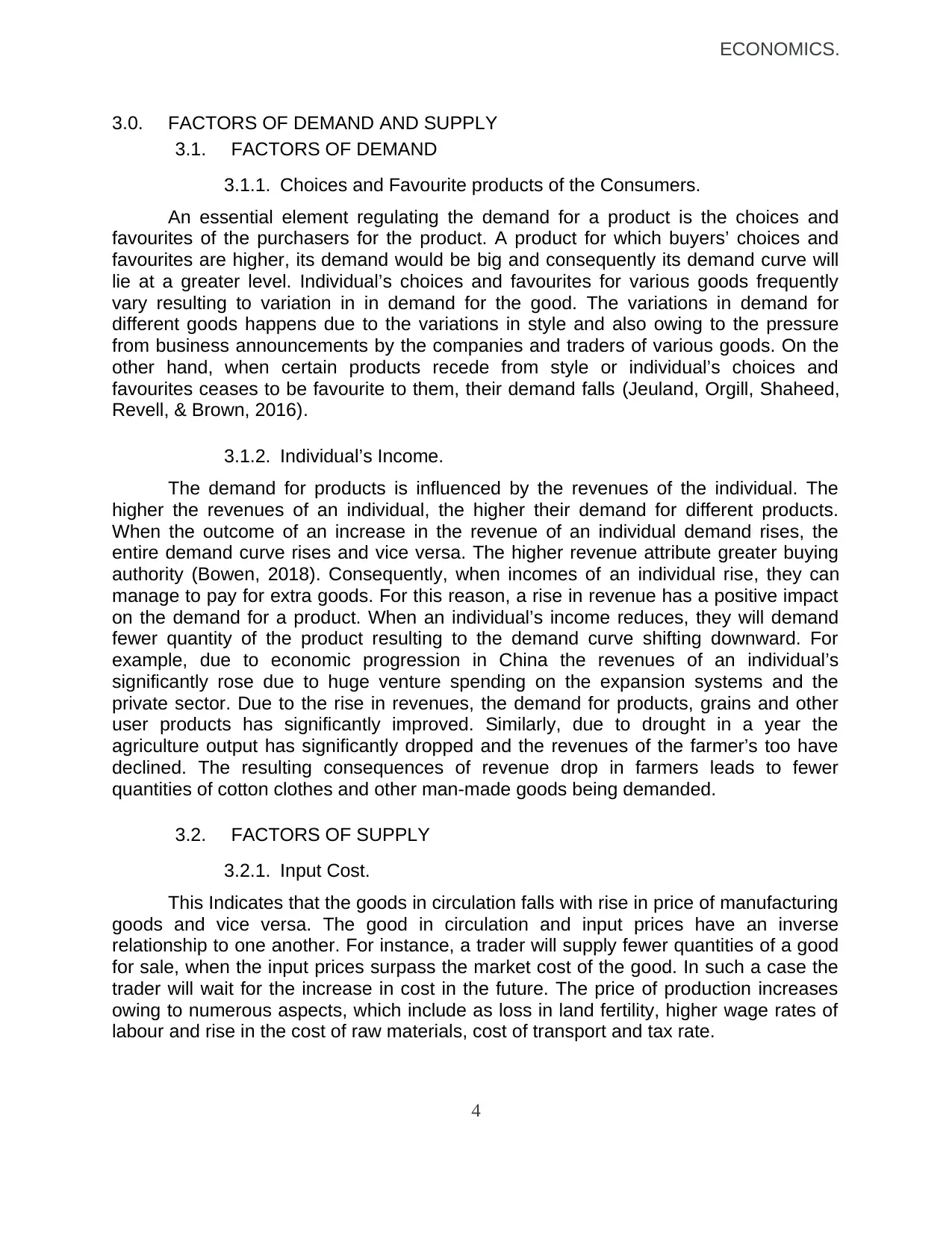
ECONOMICS.
3.0. FACTORS OF DEMAND AND SUPPLY
3.1. FACTORS OF DEMAND
3.1.1. Choices and Favourite products of the Consumers.
An essential element regulating the demand for a product is the choices and
favourites of the purchasers for the product. A product for which buyers’ choices and
favourites are higher, its demand would be big and consequently its demand curve will
lie at a greater level. Individual’s choices and favourites for various goods frequently
vary resulting to variation in in demand for the good. The variations in demand for
different goods happens due to the variations in style and also owing to the pressure
from business announcements by the companies and traders of various goods. On the
other hand, when certain products recede from style or individual’s choices and
favourites ceases to be favourite to them, their demand falls (Jeuland, Orgill, Shaheed,
Revell, & Brown, 2016).
3.1.2. Individual’s Income.
The demand for products is influenced by the revenues of the individual. The
higher the revenues of an individual, the higher their demand for different products.
When the outcome of an increase in the revenue of an individual demand rises, the
entire demand curve rises and vice versa. The higher revenue attribute greater buying
authority (Bowen, 2018). Consequently, when incomes of an individual rise, they can
manage to pay for extra goods. For this reason, a rise in revenue has a positive impact
on the demand for a product. When an individual’s income reduces, they will demand
fewer quantity of the product resulting to the demand curve shifting downward. For
example, due to economic progression in China the revenues of an individual’s
significantly rose due to huge venture spending on the expansion systems and the
private sector. Due to the rise in revenues, the demand for products, grains and other
user products has significantly improved. Similarly, due to drought in a year the
agriculture output has significantly dropped and the revenues of the farmer’s too have
declined. The resulting consequences of revenue drop in farmers leads to fewer
quantities of cotton clothes and other man-made goods being demanded.
3.2. FACTORS OF SUPPLY
3.2.1. Input Cost.
This Indicates that the goods in circulation falls with rise in price of manufacturing
goods and vice versa. The good in circulation and input prices have an inverse
relationship to one another. For instance, a trader will supply fewer quantities of a good
for sale, when the input prices surpass the market cost of the good. In such a case the
trader will wait for the increase in cost in the future. The price of production increases
owing to numerous aspects, which include as loss in land fertility, higher wage rates of
labour and rise in the cost of raw materials, cost of transport and tax rate.
4
3.0. FACTORS OF DEMAND AND SUPPLY
3.1. FACTORS OF DEMAND
3.1.1. Choices and Favourite products of the Consumers.
An essential element regulating the demand for a product is the choices and
favourites of the purchasers for the product. A product for which buyers’ choices and
favourites are higher, its demand would be big and consequently its demand curve will
lie at a greater level. Individual’s choices and favourites for various goods frequently
vary resulting to variation in in demand for the good. The variations in demand for
different goods happens due to the variations in style and also owing to the pressure
from business announcements by the companies and traders of various goods. On the
other hand, when certain products recede from style or individual’s choices and
favourites ceases to be favourite to them, their demand falls (Jeuland, Orgill, Shaheed,
Revell, & Brown, 2016).
3.1.2. Individual’s Income.
The demand for products is influenced by the revenues of the individual. The
higher the revenues of an individual, the higher their demand for different products.
When the outcome of an increase in the revenue of an individual demand rises, the
entire demand curve rises and vice versa. The higher revenue attribute greater buying
authority (Bowen, 2018). Consequently, when incomes of an individual rise, they can
manage to pay for extra goods. For this reason, a rise in revenue has a positive impact
on the demand for a product. When an individual’s income reduces, they will demand
fewer quantity of the product resulting to the demand curve shifting downward. For
example, due to economic progression in China the revenues of an individual’s
significantly rose due to huge venture spending on the expansion systems and the
private sector. Due to the rise in revenues, the demand for products, grains and other
user products has significantly improved. Similarly, due to drought in a year the
agriculture output has significantly dropped and the revenues of the farmer’s too have
declined. The resulting consequences of revenue drop in farmers leads to fewer
quantities of cotton clothes and other man-made goods being demanded.
3.2. FACTORS OF SUPPLY
3.2.1. Input Cost.
This Indicates that the goods in circulation falls with rise in price of manufacturing
goods and vice versa. The good in circulation and input prices have an inverse
relationship to one another. For instance, a trader will supply fewer quantities of a good
for sale, when the input prices surpass the market cost of the good. In such a case the
trader will wait for the increase in cost in the future. The price of production increases
owing to numerous aspects, which include as loss in land fertility, higher wage rates of
labour and rise in the cost of raw materials, cost of transport and tax rate.
4
Paraphrase This Document
Need a fresh take? Get an instant paraphrase of this document with our AI Paraphraser
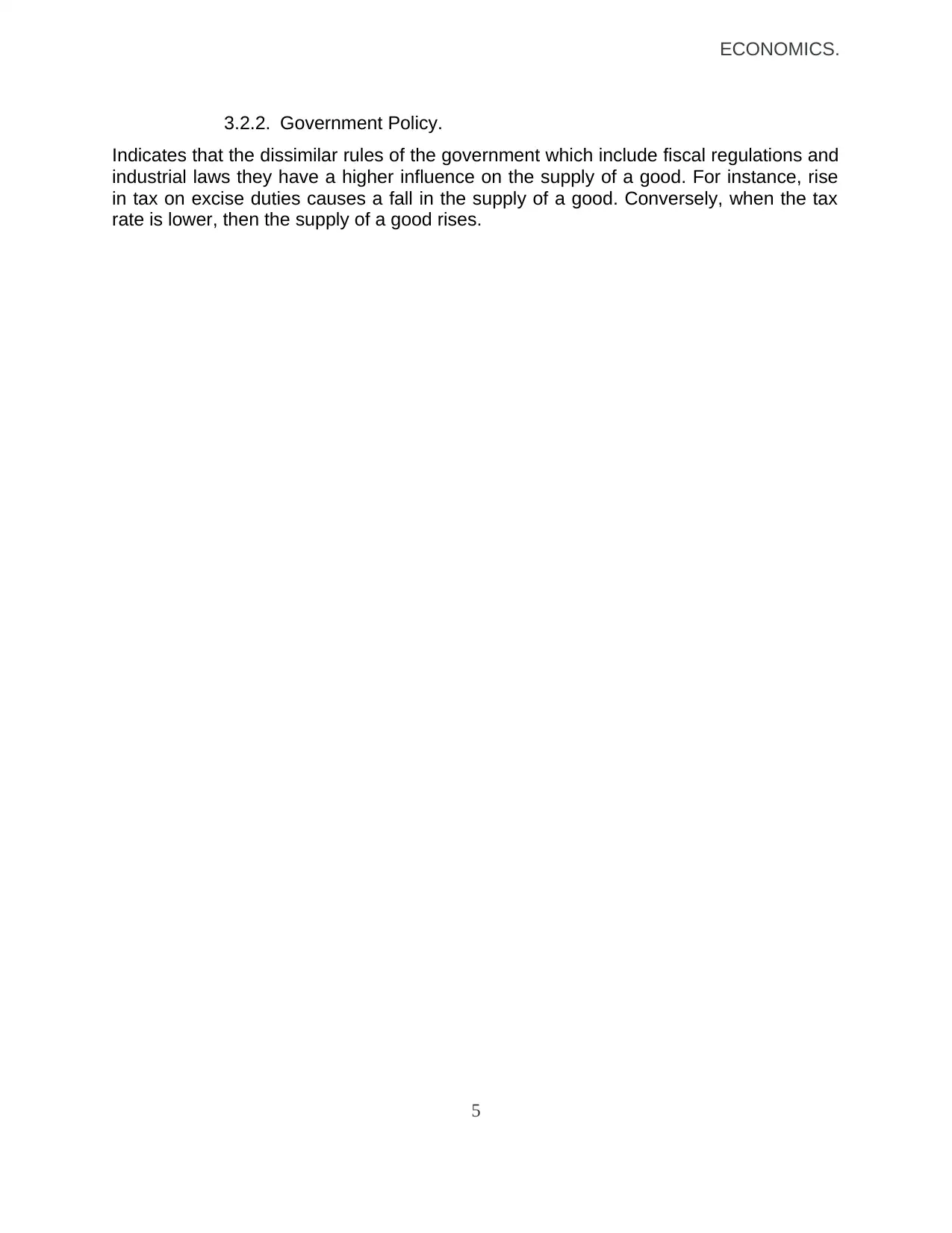
ECONOMICS.
3.2.2. Government Policy.
Indicates that the dissimilar rules of the government which include fiscal regulations and
industrial laws they have a higher influence on the supply of a good. For instance, rise
in tax on excise duties causes a fall in the supply of a good. Conversely, when the tax
rate is lower, then the supply of a good rises.
5
3.2.2. Government Policy.
Indicates that the dissimilar rules of the government which include fiscal regulations and
industrial laws they have a higher influence on the supply of a good. For instance, rise
in tax on excise duties causes a fall in the supply of a good. Conversely, when the tax
rate is lower, then the supply of a good rises.
5
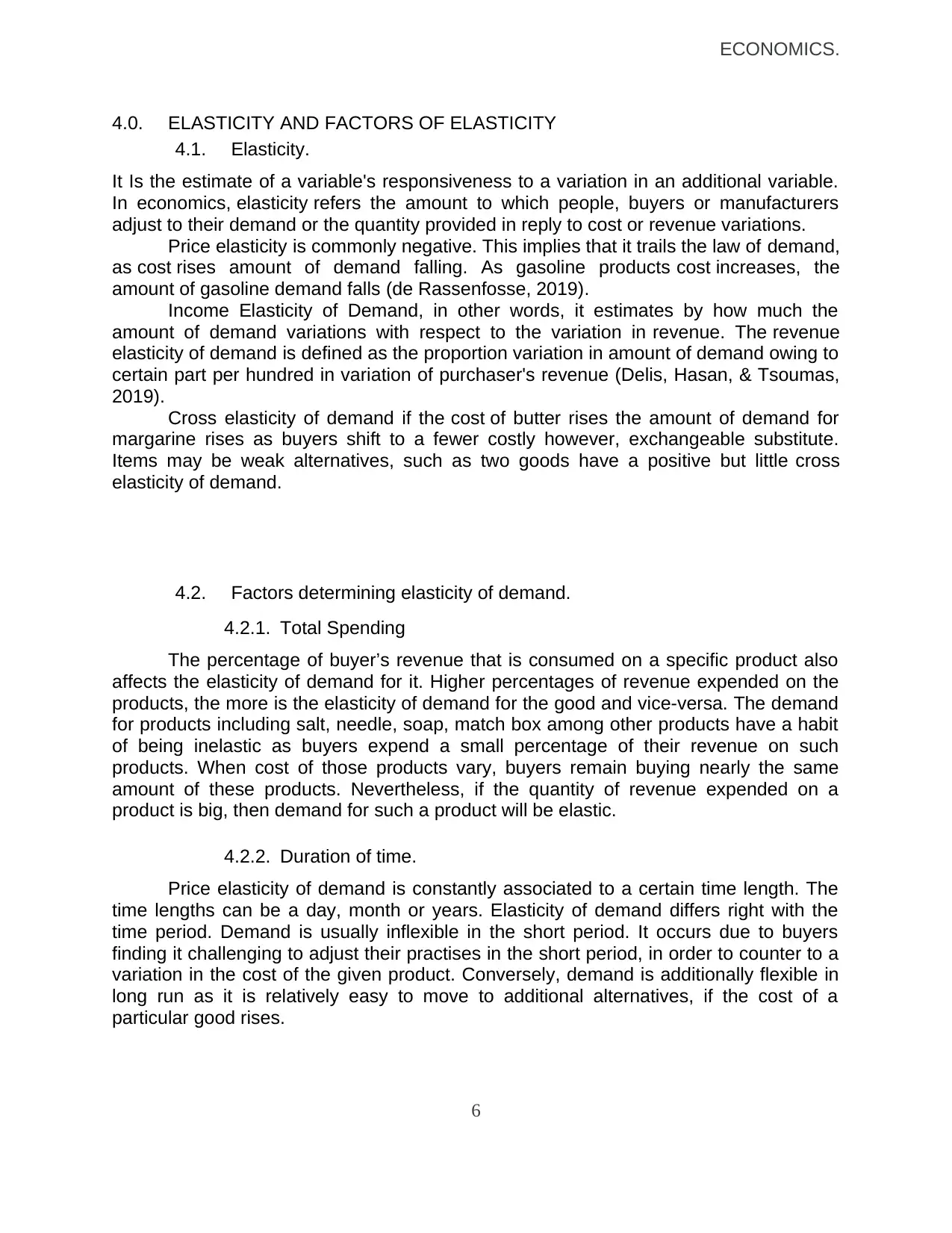
ECONOMICS.
4.0. ELASTICITY AND FACTORS OF ELASTICITY
4.1. Elasticity.
It Is the estimate of a variable's responsiveness to a variation in an additional variable.
In economics, elasticity refers the amount to which people, buyers or manufacturers
adjust to their demand or the quantity provided in reply to cost or revenue variations.
Price elasticity is commonly negative. This implies that it trails the law of demand,
as cost rises amount of demand falling. As gasoline products cost increases, the
amount of gasoline demand falls (de Rassenfosse, 2019).
Income Elasticity of Demand, in other words, it estimates by how much the
amount of demand variations with respect to the variation in revenue. The revenue
elasticity of demand is defined as the proportion variation in amount of demand owing to
certain part per hundred in variation of purchaser's revenue (Delis, Hasan, & Tsoumas,
2019).
Cross elasticity of demand if the cost of butter rises the amount of demand for
margarine rises as buyers shift to a fewer costly however, exchangeable substitute.
Items may be weak alternatives, such as two goods have a positive but little cross
elasticity of demand.
4.2. Factors determining elasticity of demand.
4.2.1. Total Spending
The percentage of buyer’s revenue that is consumed on a specific product also
affects the elasticity of demand for it. Higher percentages of revenue expended on the
products, the more is the elasticity of demand for the good and vice-versa. The demand
for products including salt, needle, soap, match box among other products have a habit
of being inelastic as buyers expend a small percentage of their revenue on such
products. When cost of those products vary, buyers remain buying nearly the same
amount of these products. Nevertheless, if the quantity of revenue expended on a
product is big, then demand for such a product will be elastic.
4.2.2. Duration of time.
Price elasticity of demand is constantly associated to a certain time length. The
time lengths can be a day, month or years. Elasticity of demand differs right with the
time period. Demand is usually inflexible in the short period. It occurs due to buyers
finding it challenging to adjust their practises in the short period, in order to counter to a
variation in the cost of the given product. Conversely, demand is additionally flexible in
long run as it is relatively easy to move to additional alternatives, if the cost of a
particular good rises.
6
4.0. ELASTICITY AND FACTORS OF ELASTICITY
4.1. Elasticity.
It Is the estimate of a variable's responsiveness to a variation in an additional variable.
In economics, elasticity refers the amount to which people, buyers or manufacturers
adjust to their demand or the quantity provided in reply to cost or revenue variations.
Price elasticity is commonly negative. This implies that it trails the law of demand,
as cost rises amount of demand falling. As gasoline products cost increases, the
amount of gasoline demand falls (de Rassenfosse, 2019).
Income Elasticity of Demand, in other words, it estimates by how much the
amount of demand variations with respect to the variation in revenue. The revenue
elasticity of demand is defined as the proportion variation in amount of demand owing to
certain part per hundred in variation of purchaser's revenue (Delis, Hasan, & Tsoumas,
2019).
Cross elasticity of demand if the cost of butter rises the amount of demand for
margarine rises as buyers shift to a fewer costly however, exchangeable substitute.
Items may be weak alternatives, such as two goods have a positive but little cross
elasticity of demand.
4.2. Factors determining elasticity of demand.
4.2.1. Total Spending
The percentage of buyer’s revenue that is consumed on a specific product also
affects the elasticity of demand for it. Higher percentages of revenue expended on the
products, the more is the elasticity of demand for the good and vice-versa. The demand
for products including salt, needle, soap, match box among other products have a habit
of being inelastic as buyers expend a small percentage of their revenue on such
products. When cost of those products vary, buyers remain buying nearly the same
amount of these products. Nevertheless, if the quantity of revenue expended on a
product is big, then demand for such a product will be elastic.
4.2.2. Duration of time.
Price elasticity of demand is constantly associated to a certain time length. The
time lengths can be a day, month or years. Elasticity of demand differs right with the
time period. Demand is usually inflexible in the short period. It occurs due to buyers
finding it challenging to adjust their practises in the short period, in order to counter to a
variation in the cost of the given product. Conversely, demand is additionally flexible in
long run as it is relatively easy to move to additional alternatives, if the cost of a
particular good rises.
6
⊘ This is a preview!⊘
Do you want full access?
Subscribe today to unlock all pages.

Trusted by 1+ million students worldwide
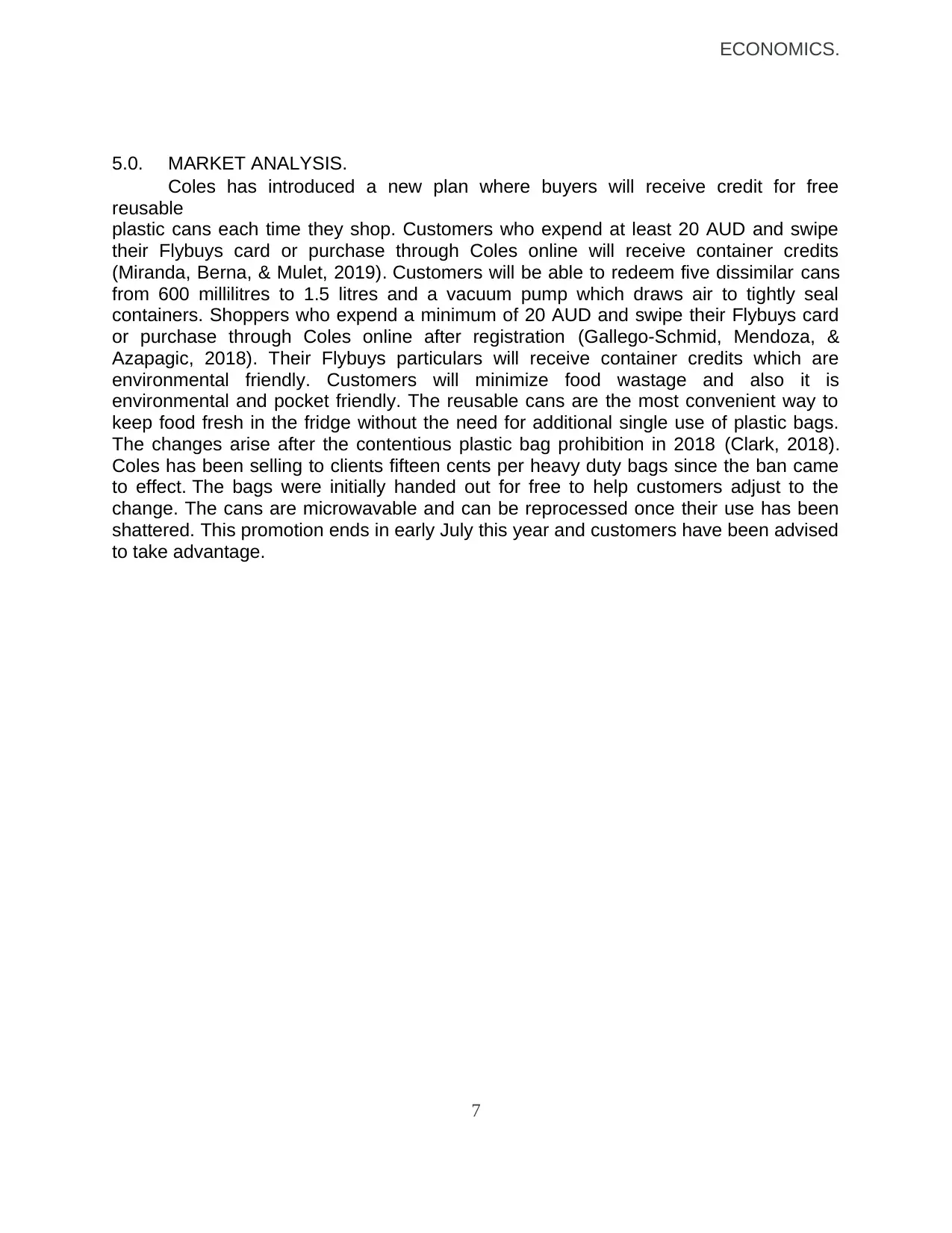
ECONOMICS.
5.0. MARKET ANALYSIS.
Coles has introduced a new plan where buyers will receive credit for free
reusable
plastic cans each time they shop. Customers who expend at least 20 AUD and swipe
their Flybuys card or purchase through Coles online will receive container credits
(Miranda, Berna, & Mulet, 2019). Customers will be able to redeem five dissimilar cans
from 600 millilitres to 1.5 litres and a vacuum pump which draws air to tightly seal
containers. Shoppers who expend a minimum of 20 AUD and swipe their Flybuys card
or purchase through Coles online after registration (Gallego-Schmid, Mendoza, &
Azapagic, 2018). Their Flybuys particulars will receive container credits which are
environmental friendly. Customers will minimize food wastage and also it is
environmental and pocket friendly. The reusable cans are the most convenient way to
keep food fresh in the fridge without the need for additional single use of plastic bags.
The changes arise after the contentious plastic bag prohibition in 2018 (Clark, 2018).
Coles has been selling to clients fifteen cents per heavy duty bags since the ban came
to effect. The bags were initially handed out for free to help customers adjust to the
change. The cans are microwavable and can be reprocessed once their use has been
shattered. This promotion ends in early July this year and customers have been advised
to take advantage.
7
5.0. MARKET ANALYSIS.
Coles has introduced a new plan where buyers will receive credit for free
reusable
plastic cans each time they shop. Customers who expend at least 20 AUD and swipe
their Flybuys card or purchase through Coles online will receive container credits
(Miranda, Berna, & Mulet, 2019). Customers will be able to redeem five dissimilar cans
from 600 millilitres to 1.5 litres and a vacuum pump which draws air to tightly seal
containers. Shoppers who expend a minimum of 20 AUD and swipe their Flybuys card
or purchase through Coles online after registration (Gallego-Schmid, Mendoza, &
Azapagic, 2018). Their Flybuys particulars will receive container credits which are
environmental friendly. Customers will minimize food wastage and also it is
environmental and pocket friendly. The reusable cans are the most convenient way to
keep food fresh in the fridge without the need for additional single use of plastic bags.
The changes arise after the contentious plastic bag prohibition in 2018 (Clark, 2018).
Coles has been selling to clients fifteen cents per heavy duty bags since the ban came
to effect. The bags were initially handed out for free to help customers adjust to the
change. The cans are microwavable and can be reprocessed once their use has been
shattered. This promotion ends in early July this year and customers have been advised
to take advantage.
7
Paraphrase This Document
Need a fresh take? Get an instant paraphrase of this document with our AI Paraphraser
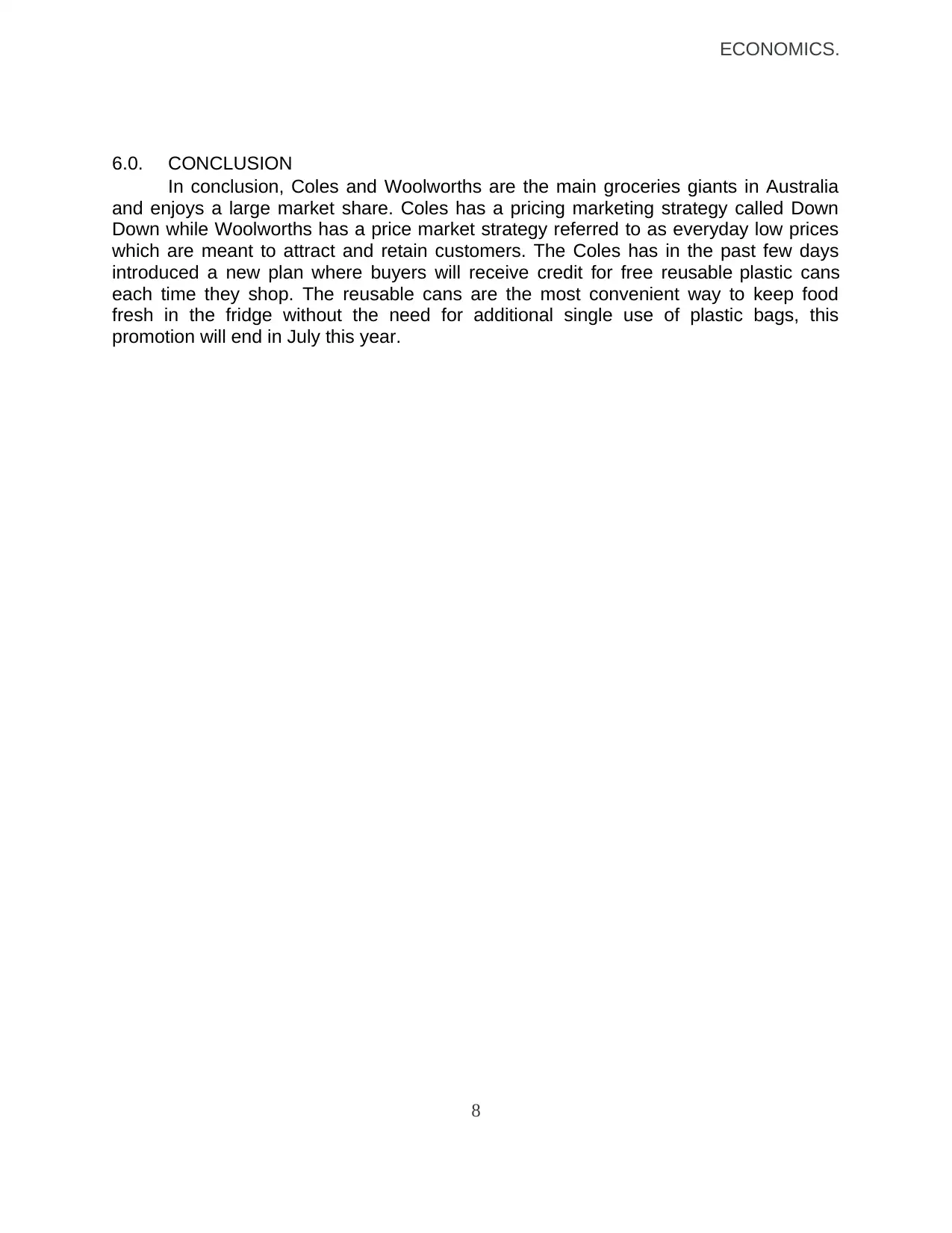
ECONOMICS.
6.0. CONCLUSION
In conclusion, Coles and Woolworths are the main groceries giants in Australia
and enjoys a large market share. Coles has a pricing marketing strategy called Down
Down while Woolworths has a price market strategy referred to as everyday low prices
which are meant to attract and retain customers. The Coles has in the past few days
introduced a new plan where buyers will receive credit for free reusable plastic cans
each time they shop. The reusable cans are the most convenient way to keep food
fresh in the fridge without the need for additional single use of plastic bags, this
promotion will end in July this year.
8
6.0. CONCLUSION
In conclusion, Coles and Woolworths are the main groceries giants in Australia
and enjoys a large market share. Coles has a pricing marketing strategy called Down
Down while Woolworths has a price market strategy referred to as everyday low prices
which are meant to attract and retain customers. The Coles has in the past few days
introduced a new plan where buyers will receive credit for free reusable plastic cans
each time they shop. The reusable cans are the most convenient way to keep food
fresh in the fridge without the need for additional single use of plastic bags, this
promotion will end in July this year.
8
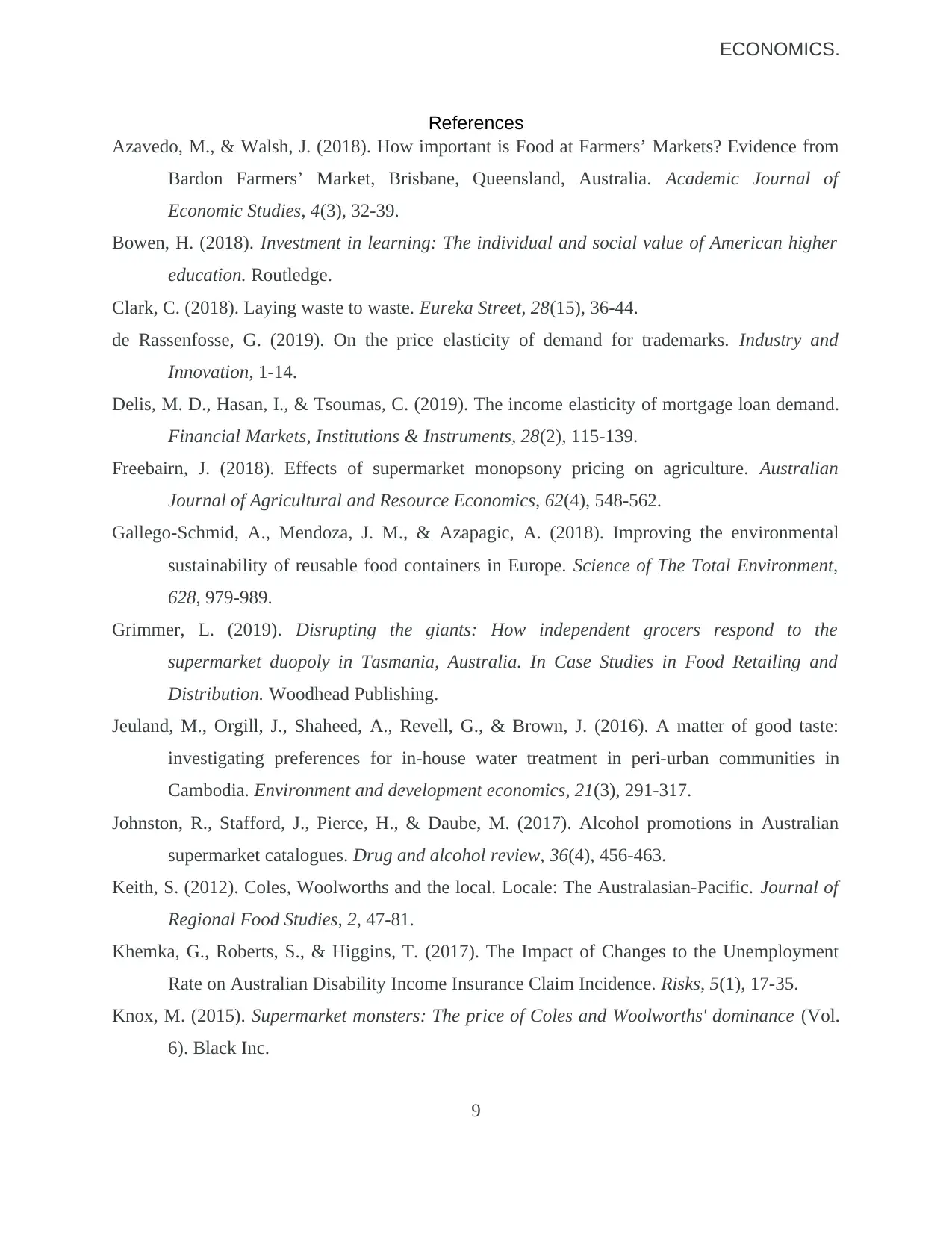
ECONOMICS.
References
Azavedo, M., & Walsh, J. (2018). How important is Food at Farmers’ Markets? Evidence from
Bardon Farmers’ Market, Brisbane, Queensland, Australia. Academic Journal of
Economic Studies, 4(3), 32-39.
Bowen, H. (2018). Investment in learning: The individual and social value of American higher
education. Routledge.
Clark, C. (2018). Laying waste to waste. Eureka Street, 28(15), 36-44.
de Rassenfosse, G. (2019). On the price elasticity of demand for trademarks. Industry and
Innovation, 1-14.
Delis, M. D., Hasan, I., & Tsoumas, C. (2019). The income elasticity of mortgage loan demand.
Financial Markets, Institutions & Instruments, 28(2), 115-139.
Freebairn, J. (2018). Effects of supermarket monopsony pricing on agriculture. Australian
Journal of Agricultural and Resource Economics, 62(4), 548-562.
Gallego-Schmid, A., Mendoza, J. M., & Azapagic, A. (2018). Improving the environmental
sustainability of reusable food containers in Europe. Science of The Total Environment,
628, 979-989.
Grimmer, L. (2019). Disrupting the giants: How independent grocers respond to the
supermarket duopoly in Tasmania, Australia. In Case Studies in Food Retailing and
Distribution. Woodhead Publishing.
Jeuland, M., Orgill, J., Shaheed, A., Revell, G., & Brown, J. (2016). A matter of good taste:
investigating preferences for in-house water treatment in peri-urban communities in
Cambodia. Environment and development economics, 21(3), 291-317.
Johnston, R., Stafford, J., Pierce, H., & Daube, M. (2017). Alcohol promotions in Australian
supermarket catalogues. Drug and alcohol review, 36(4), 456-463.
Keith, S. (2012). Coles, Woolworths and the local. Locale: The Australasian-Pacific. Journal of
Regional Food Studies, 2, 47-81.
Khemka, G., Roberts, S., & Higgins, T. (2017). The Impact of Changes to the Unemployment
Rate on Australian Disability Income Insurance Claim Incidence. Risks, 5(1), 17-35.
Knox, M. (2015). Supermarket monsters: The price of Coles and Woolworths' dominance (Vol.
6). Black Inc.
9
References
Azavedo, M., & Walsh, J. (2018). How important is Food at Farmers’ Markets? Evidence from
Bardon Farmers’ Market, Brisbane, Queensland, Australia. Academic Journal of
Economic Studies, 4(3), 32-39.
Bowen, H. (2018). Investment in learning: The individual and social value of American higher
education. Routledge.
Clark, C. (2018). Laying waste to waste. Eureka Street, 28(15), 36-44.
de Rassenfosse, G. (2019). On the price elasticity of demand for trademarks. Industry and
Innovation, 1-14.
Delis, M. D., Hasan, I., & Tsoumas, C. (2019). The income elasticity of mortgage loan demand.
Financial Markets, Institutions & Instruments, 28(2), 115-139.
Freebairn, J. (2018). Effects of supermarket monopsony pricing on agriculture. Australian
Journal of Agricultural and Resource Economics, 62(4), 548-562.
Gallego-Schmid, A., Mendoza, J. M., & Azapagic, A. (2018). Improving the environmental
sustainability of reusable food containers in Europe. Science of The Total Environment,
628, 979-989.
Grimmer, L. (2019). Disrupting the giants: How independent grocers respond to the
supermarket duopoly in Tasmania, Australia. In Case Studies in Food Retailing and
Distribution. Woodhead Publishing.
Jeuland, M., Orgill, J., Shaheed, A., Revell, G., & Brown, J. (2016). A matter of good taste:
investigating preferences for in-house water treatment in peri-urban communities in
Cambodia. Environment and development economics, 21(3), 291-317.
Johnston, R., Stafford, J., Pierce, H., & Daube, M. (2017). Alcohol promotions in Australian
supermarket catalogues. Drug and alcohol review, 36(4), 456-463.
Keith, S. (2012). Coles, Woolworths and the local. Locale: The Australasian-Pacific. Journal of
Regional Food Studies, 2, 47-81.
Khemka, G., Roberts, S., & Higgins, T. (2017). The Impact of Changes to the Unemployment
Rate on Australian Disability Income Insurance Claim Incidence. Risks, 5(1), 17-35.
Knox, M. (2015). Supermarket monsters: The price of Coles and Woolworths' dominance (Vol.
6). Black Inc.
9
⊘ This is a preview!⊘
Do you want full access?
Subscribe today to unlock all pages.

Trusted by 1+ million students worldwide
1 out of 16
Related Documents
Your All-in-One AI-Powered Toolkit for Academic Success.
+13062052269
info@desklib.com
Available 24*7 on WhatsApp / Email
![[object Object]](/_next/static/media/star-bottom.7253800d.svg)
Unlock your academic potential
Copyright © 2020–2025 A2Z Services. All Rights Reserved. Developed and managed by ZUCOL.





